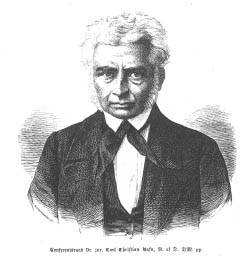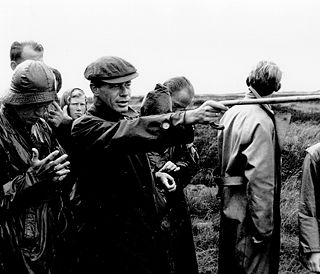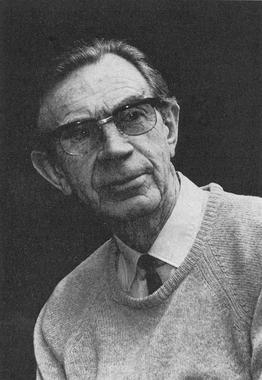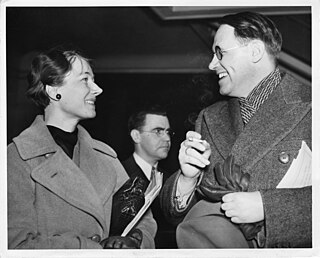Related Research Articles

Carl Christian Rafn was a Danish historian, translator and antiquarian. His scholarship to a large extent focused on translation of Old Norse literature and related Northern European ancient history. He was also noted for his early advocacy of the recognition of Norse colonization of North America.

Christen Christensen Raunkiær was a Danish botanist, who was a pioneer of plant ecology. He is mainly remembered for his scheme of plant strategies to survive an unfavourable season and his demonstration that the relative abundance of strategies in floras largely corresponded to the Earth's climatic zones. This scheme, the Raunkiær system, is still widely used today and may be seen as a precursor of modern plant strategy schemes, e.g. J. Philip Grime's CSR system.

Lorenz Peter Elfred Freuchen was a Danish explorer, author, journalist and anthropologist. He is notable for his role in Arctic exploration, namely the Thule Expeditions.

Tyge Wittrock Böcher was a Danish botanist, evolutionary biologist, plant ecologist and phytogeographer.
The Royal Danish Geographical Society is a scientific society aimed at furthering the knowledge of the Earth and its inhabitants and to disseminate interest in the science of geography.

Carl Emil Hansen Ostenfeld was a Danish systematic botanist. He graduated from the University of Copenhagen under professor Eugenius Warming. He was a keeper at the Botanical Museum 1900–1918, when he became professor of botany at the Royal Veterinary and Agricultural University. In 1923, by the early retirement of Raunkiær's, Ostenfeld became professor of botany at the University of Copenhagen and director of the Copenhagen Botanical Garden, both positions held until his death in 1931. He was a member of the Royal Danish Academy of Sciences and Letters and served on the board of directors of the Carlsberg Foundation.
Olaf Hagerup was a Danish botanist. He studied botany at the University of Copenhagen from 1911 under the professors Eugenius Warming, Christen C. Raunkiær, L. Kolderup Rosenvinge og W. Johannsen. He took his Ph.D. from the same university in 1930. From 1934 to 1960, he was superintendent at the Botanical Museum of the University of Copenhagen.

Knud Jessen was a Danish botanist and quaternary geologist.

Otto Fabricius was a Danish missionary, naturalist, ethnographer, and explorer of Greenland.

Morten Pedersen Porsild was a Danish botanist who lived and worked most of his adult life in Greenland. He participated in expeditions to Greenland in 1898 and 1902, together with the physiologist August Krogh. In 1906, he founded the Arctic Station in Qeqertarsuaq, West Greenland, since 1956 part of the University of Copenhagen. He got support from famous polar researchers like Knud Rasmussen, Mylius-Erichsen and Fridtjof Nansen. A private person donated the building and running cost were put directly on the Danish state budget. Morten Porsild managed the station for forty years. He received the Hans Egede Medal in 1921. In 1946, he returned to Copenhagen, and was succeeded as station head by Paul Gelting. He was the father of Alf Erling Porsild, Robert Thorbjørn Porsild, Asta Irmelin "Tulle" Egede and Ove Sten Porsild.

Thorvald (Thorwald) Julius Sørensen was a Danish botanist and evolutionary biologist.
Henning Eiler (Ejler) Petersen was a Danish mycologist, botanist and marine biologist. He made a major contribution to unveiling the mysterious die-back of eel grass in Northern European waters in the early 20th century as a pathogen outbreak.
Events in the year 1772 in Norway.

Ole Olufsen was a Danish military officer and explorer. He made several notable expeditions in the 1890s to the Emirate of Bukhara, including the Pamir Mountains. He also served as Secretary of the Royal Danish Geographical Society. Olufsen was a proponent of the idea that the peoples of the Pamirs retained traits of Avestan culture, a notion borrowed from the works of Wilhelm Geiger and Karoly Jeno Ujfalvy de Mezo-Kovesd, and that the region was still populated by adherents of Zoroastrianism. During his 1898-99 expeditions to the Pamirs, Olufsen was accompanied by Danish botanist Ove Paulsen.

Kaj Birket-Smith was a Danish philologist and anthropologist. He specialized in studying the habits and language of the Inuit and Eyak. He was a member of Knud Rasmussen's 1921 Thule expedition. In 1940, he became director of the Ethnographic Department of the National Museum of Denmark.

Jens Wilhelm August Lind was a Danish apothecary, botanist and mycologist. He was a pupil of Emil Rostrup and published a full account of all fungi collected in Denmark by Rostrup. These were mainly microfungi, such as plant pathogens. He also wrote accounts on microfungi from Greenland and elsewhere, mainly based on collections made by other persons on expeditions, e.g. Gjøa expedition and the Second Thule Expedition. Combining his pharmaceutical and mycological knowledge, he was early in experimenting on chemical control of plant pathogens and recommending it to other practitioners. He also - together with Knud Jessen - wrote an account on the immigration history of weeds to Denmark.

Vice Admiral Sir Georg Carl Amdrup, RN was a Danish naval officer, Vice Admiral and Greenland researcher.

Erich Christian Werlauff was a Danish historian, librarian and professor.

Hans Peder Steensby was an ethnographer, geographer and professor at the University of Copenhagen.
Børge Fristrup was a Danish geographer. He studied glaciology, specialising in the Greenland ice sheet, at the University of Copenhagen and at Stockholm University, receiving a Hans Egede Medal for his research in 1971.
References
- ↑ "EGEDE MEDAILLEN". Royal Danish Geographical Society. Archived from the original on 10 February 2017. Retrieved 30 November 2016.
- ↑ Andreassen, J. (2015). Altid frimodig: Biografi om polarforskeren, forfatteren og eventyreren Peter Freuchen (in Danish). Gyldendal. p. 172. ISBN 978-87-02-18590-4 . Retrieved 26 June 2023.
- ↑ Botaniske forening i København (1955). Botanisk Tidsskrift. Botanisk tidsskrift (in Danish). H. Hagerups Forlag. p. 119. ISSN 0006-8187 . Retrieved 26 June 2023.
- ↑ Müller, P.; Pedersen, J.V. (1968). Foregangsmaend. Foregangsmaend (in Danish). Gyldendal. p. 179. Retrieved 26 June 2023.
- ↑ Grønland (in Danish). Det Grønlandske Selskab. 1957. p. 8. Retrieved 26 June 2023.
- ↑ Grønland (in Danish). Det Grønlandske Selskab. 1992. p. 239. Retrieved 26 June 2023.
- ↑ Kongelige Danske geografiske selskab; Erslev, E.; Irminger, O.F.H.; Olufsen, O.; Castonier, E.; Nielsen, N. (1931). Geografisk tidsskrift (in Danish). Forlagt af Selskabet. p. 1. Retrieved 26 June 2023.
- ↑ Elberling, V.; Hjelmstjerne-Rosencroneske stiftelse (1932). Avis-aarbogen ...: Aarets begivenheder hjemme og ude i faa orde (in Danish). C. A. Reitzel. p. 91. Retrieved 26 June 2023.
- ↑ Elberling, V.; Hjelmstjerne-Rosencroneske stiftelse (1933). Avis-aarbogen ...: Aarets begivenheder hjemme og ude i faa orde (in Danish). C. A. Reitzel. p. 161 ff. Retrieved 26 June 2023.
- ↑ Dahl, S.; Danske selskab (Copenhagen, Denmark) (1943). Danmarks kultur ved aar 1940: bd. Den videnskabelige kultur. Danmarks kultur ved aar 1940 (in Danish). Danske forlag. p. 81. Retrieved 26 June 2023.
- ↑ Grønland (in Danish). Det Grønlandske Selskab. 1957. p. 9. Retrieved 26 June 2023.
- ↑ Aldrich, R.; Wotherspoon, G. (2020). Who'S Who in Contemporary Gay and Lesbian History. Taylor & Francis. p. 233. ISBN 978-1-00-010075-4 . Retrieved 26 June 2023.
- ↑ Kongelige Danske geografiske selskab (1983). Geografisk tidsskrift (in Norwegian). H. Hagerup. p. iii. Retrieved 26 June 2023.
- ↑ Kongelige Danske geografiske selskab (1959). Geografisk tidsskrift (in Norwegian). H. Hagerup. p. vi. Retrieved 26 June 2023.
- ↑ Kongelige Danske geografiske selskab (1960). Geografisk tidsskrift (in Danish). Kongelige danske geografiske selskabet. p. x. ISSN 0016-7223 . Retrieved 26 June 2023.
- ↑ "Byen under isen" (in Danish). Københavns Universitet. 3 May 2022. Archived from the original on 26 February 2021. Retrieved 26 June 2023.
- ↑ "Børge Fristrup". Dansk Biografisk Leksikon (in Danish). 17 August 2014. Archived from the original on 21 January 2022. Retrieved 26 June 2023.
- ↑ "Knud Ellitsgaard-Rasmussen". Dansk Biografisk Leksikon (in Danish). 13 July 2012. Archived from the original on 19 January 2022. Retrieved 26 June 2023.
- ↑ "Jørgen Meldgaard". Dansk Biografisk Leksikon (in Danish). 13 July 2012. Archived from the original on 19 October 2021. Retrieved 26 June 2023.
- ↑ Kongelige Danske geografiske selskab (1980). Geografisk tidsskrift (in Norwegian). H. Hagerup. p. 134. Retrieved 26 June 2023.
- ↑ Magnusson, Magnus (12 January 2020). "Gunnar Østrem, 1922–2020 – IGS". IGS. Archived from the original on 29 March 2023. Retrieved 26 June 2023.
- ↑ Kongelige Danske geografiske selskab (1983). Geografisk tidsskrift (in Norwegian). H. Hagerup. p. ii. Retrieved 26 June 2023.
- ↑ "Preben E. Gudmandsen, DTU veteran scientist, dies at 94". www.space.dtu.dk. 2 May 2019. Retrieved 26 June 2023.
- ↑ "Visning af: DET KONGELIGE DANSKE GEOGRAFISKE SELSKAB". Geografisk Tidsskrift (in Danish). 1 January 1992. Archived from the original on 18 June 2022. Retrieved 26 June 2023.
- ↑ "Visning af: Hans Egede Medaillen". Geografisk Tidsskrift (in Danish). 1 January 1998. Archived from the original on 18 June 2022. Retrieved 26 June 2023.
- ↑ "Head of Center Bo Elberling receives the Hans Egede Medal". Danish National Research Foundation. Archived from the original on 20 July 2018. Retrieved 20 July 2018.
- ↑ "Dorthe Dahl-Jensen awarded Hans Egede Medal". Niels Bohr Institute.